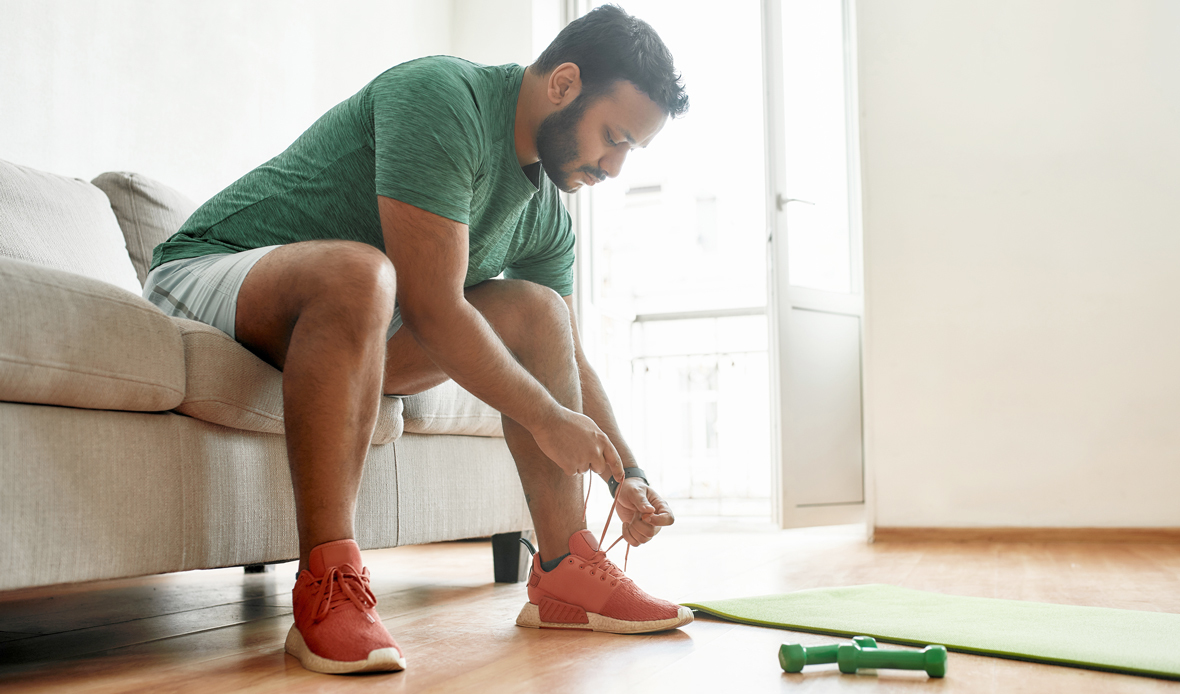
Finding time to exercise can be tough. But here’s a little secret: You can move more, even when life gets overwhelming, by simply setting yourself up for success. Here are a few simple ways.
Most of us spend way more than five minutes a day scrolling through the news or social media feeds. Try replacing even one screen session with something more active. Research has shown that every bit of movement counts; five minutes here and there over the course of a day or a week can add up to better cardiovascular health and weight management.1
The best results come with movement that’s moderate intensity: Think brisk walk, weeding the garden, or cycling 10 to 15 miles an hour.
When someone is counting on you, you’re more likely to show up. Put something in your weekly plan that requires movement and keeps you accountable. Bonus: you get an extra dose of personal or professional connection.
Consider a walking meeting with a colleague or a stroll to pick up coffee. Of course, in pandemic times make sure your plans keep you at a safe distance. You don’t even need to be in the same place to make meetup motivation work for you. Throw on the headphones and enjoy a virtual walking date to catch up with a friend—just make sure to stay safe and avoid traffic when you’re multitasking.
Having the right gear handy can boost your chances of fitting movement into your day. Tuck a pair of walking shoes by the door or in your car and you’ll be more likely to slip out for a brisk walk or two during the workday. Keep a raincoat or umbrella handy so bad weather can’t dampen a lunchtime stroll.
Some people even sleep in exercise clothes. That’s one less barrier if you’re already dressed to move when your alarm goes off. Whether it’s 10 minutes of stretching or 15 minutes spinning on the exercise bike, it’s a healthy way to start the day.
Forget about “exercise.” Instead, make a list of things you enjoy that require some kind of movement—any kind of movement. Swinging at a playground, dancing to hip hop, throwing a frisbee, window shopping, jumping rope, or riding a bike. Choose one thing from your list that doesn’t require extra effort and do that thing. One day or every day, five minutes or 30; just plain fun will give you a physical and mental boost.
When you fail to meet a goal you’ve set for yourself, don’t go too hard on yourself. A growing body of research shows being kind to yourself is actually more effective. “Self-compassion” makes it more likely you’ll reach your goals by trying again. You’ll worry less about future success and reduce the chance negative thoughts will stand in your way.2
Here are three small steps to practice self-compassion:
It’s one more way you can take care of yourself on the road to a more active way of living.
A MOBE Guide can help you find even more ways to move toward better health and more happiness. Get started today.
References:
1. Nicole Glazer, et al., “Sustained and Shorter Bouts of Physical Activity Are Related to Cardiovascular Health,” Medicine and Science in Sports and Exercise 45, no. 1 (January 2013): 109-115, https://journals.lww.com/acsm-msse/Fulltext/2013/01000/Sustained_and_Shorter_Bouts_of_Physical_Activity.16.aspx.
2. Brittany N. Semenchuk, et al., “Self-Compassion and the Self-Regulation of Exercise: Reactions to Recalled Exercise Setbacks,” Journal of Sport and Exercise Psychology 40, no. 1 (2017): 31-39, https://journals.humankinetics.com/view/journals/jsep/40/1/article-p31.xml.
3. "Self-Compassion Break,” Greater Good in Action: Science-based Practices for a Meaningful Life, University of California, Berkeley, https://ggia.berkeley.edu/practice/self_compassion_break.